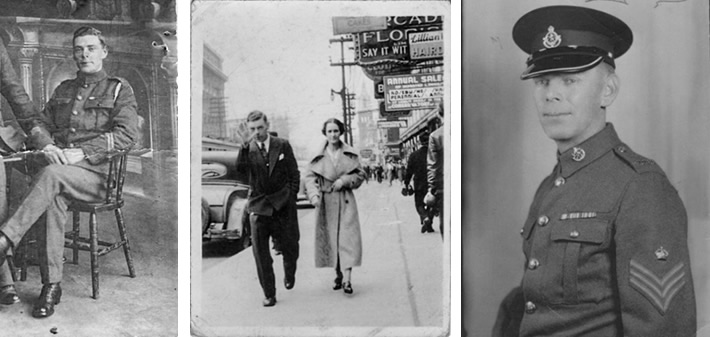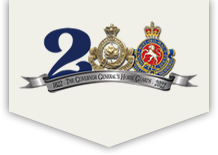our stories
George Henry Rick March 7th, 2016
Hello my name is Brenda Castle from Nottingham, England. George Henry Rick is my husband’s great uncle – my husband’s name is Brian Allen Castle and George was Brian’s Grandmother (Emma Desmond Castle nee Rick}’s brother.
We are researching George because of a photo we have of him which our Medals and insignia department of the Ministry of Defence tell us is probably the cap badge of the Governor General of Canada’s Horse Guards. We have researched it on line also and the Unicorn makes it a unique badge, apparently, and they say certainly not a regimental badge attached to any of our British regiments over here.
We are trying to find out what happened to George after he returned from the 1st WW. We know he came to Canada in 1927 because we the passenger lists from the Astonia and George his wife Mable and their Daughter Dorothy are passengers arriving in Canada in June of that year. We also have a picture of him on a street in Toronto (we think) with what is possibly his wife Mable.
George was born in Upton, Nottinghamshire, England in 1894/5.
Can you give me a contact email for the regiment – or someone who can identify the badge for us.
Kind regards Brenda Castle.

RESPONSE 1
I am, Maj Scott Duncan, the unit historian.
I can tell you that the uniform and insignia of this photograph dates the photograph to the period 1936 to 1940. The Governor General’s Horse Guards (GGHG) were formed with the amalgamation of the Governor General’s Body Guard and the Mississauga Horse in 1936. They did not have the GGHG insignia approved until 1938 and the blue forge cap was not introduced until 1939.
Therefore I would suggest this pic is WWII era. It has to be before 1941, because this service dress was replaced by Battle Dress in that year. He probably served with the Governor General’s Horse Guards Reserve Regiment, not the active Regiment overseas. Most of the reserve regiments were manned by WWI veterans and served much like your Home Guard units during the war. He holds the rank of Staff Sergeant.
The unicorn was originally a symbol used on the badge of the Mississauga Horse and is actually taken from the national Coat of Arms. It was adopted at the time of amalgamation when a committee chose to meld the insignia of the two old regiments in 1938. If you note on the national coat of arms of both the UK and Canada there is a lion rampant on the left and the unicorn on the right chained and collared. If you put the unicorn badge next to an image of the coat of arms you will find it an exact copy. The unicorn is a symbol of Scotland. We are not sure of the reasoning for the choice of this symbol, but we do know that the first CO of the Mississauga Horse was a Scotsman by the names of LCol Peters.
Thanks for the photo. We will keep it on our records in our archive. I hope this helps with your research.
Maj Scott Duncan
GGHG
QUESTION 2
The photos look good in black and white and I notice the photo of George with his brother in law Hedley Castle. Now that it’s black and white, is easier to see the detail of the other uniform.
We noticed that the stripes on the sleeve are the opposite way up and there is a lanyard on his shoulder. Is this still the GGHG uniform (perhaps the 1941 Battle dress mentioned by Major Duncan)? This has always puzzled us and we initially thought that it may be a WW1 British uniform. George would have been 20yrs old when the war ( WW II) broke out and I’ve always wonder if this was his British battle dress. What do you think?
We haven’t as yet located his soldier’s records because we have no idea which regiment he was in. That’s one of my next jobs to do on his profile. It’s much harder, in England, to get soldiers records when they survived and came home. One of the criteria is that you must be a blood relative and at the moment I don’t know whether we would qualify for that, our relationship, as Castles, only makes Brian (my husband, his great uncle.) I don’t think would apply, I think we would have to be a Rick……don’t know…. it is something I have to look into.
Anyway thanks again for all your help!
Kind regards Brenda.
Brenda Castle
RESPONSE 2
Brenda,
Phillip sent me this request to analyse the second photo of your uncle seated. He is much younger in this photo and I would suggest this is late war or end of war 1917 to 1919.
The reason I suggest this is that he is wearing a single medal, the 1914 star or Mons Star, issued early in the war. The War and Victory medals were issued at the end of hostilities 1918-19. Further, he wears 4 inverted small stripes on his lower right sleeve indicating 4 years of service. This would imply he was at war from 1914 to 1918.
On his lower left sleeve he wears two large inverted stripes that are issued for good conduct. He holds no rank on his upper sleeve so he is a Pte. Normally units had collar dogs, a metal device in the form of a regiment’s or corps insignia emblem. He has none showing. This makes it hard to identify his unit. He has a title on his shoulder board. Very hard to read, but it is curved almost horseshoe shaped, which is typical of British Regiments. Unlikely he was with a Corps (Artillery, Engineers or Signals). Their shoulder titles are usually elongated or straight. If you can find a unit that had no collars worn it may help to identify. He is wearing straight leg pants without puttees, this is typical of post war walking out dress. Not much else I can tell you from the picture.
The white lanyard is often a regimental coloured identifier usually ending in the left breast pocket with a whistle or a bottle opener. If you can find a reference to British regimental lanyard colours you may be able to narrow the search.
As for the application for his docs, if you don’t ask you won’t get. I hope this helps.
Maj Duncan
GGHG
